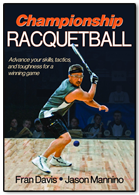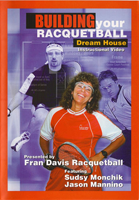 Athletes thrive on consistency and routine. We are creatures of habit and perform best when there are no surprises. In order to obtain optimal performance levels, you need a pre-performance routine.
Athletes thrive on consistency and routine. We are creatures of habit and perform best when there are no surprises. In order to obtain optimal performance levels, you need a pre-performance routine.
How Is a Routine Created?
1. Behavior: An athlete chooses certain behaviors that enhance their game (e.g., bouncing the ball three times before serving).
2. Habit: A behavior done over and over again (seven times) becomes a habit. If you bounce the ball three times every time you serve, you will eventually do it unconsciously.
3. Routine: A healthy habit soon becomes a routine. As you are preparing for your upcoming match, you choose specific routines that you think will guarantee consistency and success. Bouncing the ball three times has now become a necessary routine since you stop thinking about your serve and go into it automatically.
There are many samples of routines in my book, “Championship Racquetball” in Chapter 9, P. 221-223, so check it out they will really help.
All my athletes from legends Jason Mannino and Sudsy Monchik, when they were playing the pro tour, to Rocky Carson, Paola Longoria and Taylor Knoth, who are presently playing the pro tour, ALL have routines. Their routines start the night before and include the morning of the match, to driving to the club, prior to the match and then in the game.
Let’s examine what tools Rocky and all my athletes use to develop routines by taking a closer look at all 3 sides of The Sports Racquetball Triangle: Conditioning, Mental, and Physical Skills
Left Side of the Triangle
Conditioning
Based on what season you are in (Pre-Season, In-Season, or Post-Season) you will need to develop your conditioning program. No matter what season you are in though, you will want to have a set routine of how many days per week that you will condition and work on your strength, speed, aerobic conditioning and stretching.
Rocky’s conditioning routine:
“I head to the club 3 mornings a week after I drop my kids off to school and meet up with my trainer, who works me out on my particular conditioning program based on what season I am in. I never miss as the routine keeps me grounded and very focused.”
Use the techniques in my book Championship Racquetball, Chapter 10, to develop your conditioning routine.
Nutrition
Dehydration is the # 1 cause of poor performance. Even if you become slightly dehydrated you instantly lose your power, speed and accuracy. Your brain, muscles and all neural-electrical connections need enough body water and fluids in order to perform at their best. Therefore you want to make sure you DRINK plenty of water…the best for hydration. Start with hydrating your body with at least (60 – 100 oz) of water each day, which is over seven 8 oz. glasses of water a day. If you stay hydrated you will have betterreflexes, power, speed, accuracy and timing. Plus your focus and concentration will be sharper.
Jason water’s routine:
“I carry around a gallon jug everywhere I go. I start to hydrate two days before each match and I drink 12 oz of water each hour before as well as after my match. I know I am drinking enough when I live in the bathroom.”
Right Side of the Triangle
Mental Skills
Controlling your emotions is critical and in this open era there is no psyching up or psyching down. An athlete wants to be calm, centered, and emotionally still for the purest responses and accuracy. Too much hype is distracting and upsets precision and timing. The fastest responses come from a still, calm, and relaxed body. Watch a cat ready to pounce on a mouse: It is 100 percent calm, centered, and focused. That is exactly how you want to be on the court—physically relaxed, mentally empty of all thoughts, and emotionally calm.
Paola’s routine to be in control of her emotions:
“One hour before my match I get on the elliptical with my iPod and head phones and listen to some motivational tapes as it allows me to be calm and in control of my emotions when I play.”
More details on how to control your emotions can be found in my book, Championship Racquetball, in Chapter 9.
Base of the Triangle
Physical Skills
Just like with conditioning, your physical skills are based on what season you are in (Pre-Season, In-Season, or Post-Season) and you will need to determine your physical skills workout based on that information. No matter what season you are in, you will want to develop a diligent routine of drilling, practicing and playing a set number of days per week.
Paola’s routine to drill, practice and play is like no other:
“I drill, practice or play 4 four days per week late in the afternoon after I head home from school and grab a bite to eat. I make sure if it is a playing/sparring day I have my workout partner picked.
For details and tips on more personalized instruction, a weekend camp, instructional DVD’s, our book, Championship Racquetball, and our APP (coming soon), ALL which covers all aspects of the Sports Racquetball Triangle and more, please visit www.FranDavisRacquetball.com.Fran Davis is a 2004 racquetball Hall of Fame inductee, Racquetball Woman of the Year 2009, Coach #2 IRT Pro Player and 1X US Open Champion, Rocky Carson; Coach #1 Women’s LPRT Pro Player and 4X and present US Open Champion, Paola Longoria; Coach Jr. World & National Champion, Intercollegiate Champion, & IRT Pro Player, Taylor Knoth; Coach Intercollegiate Champion & LPRT Pro Player, Sharon Jackson; Master Professional Instructor/Coach USAR-IP. International Racquetball Tour.










